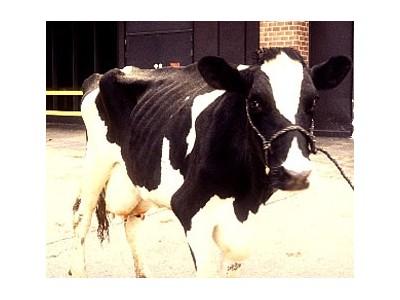Cow Health: Johnes Disease in cow

Johne's Disease is a chronic, contagious and sometimes fatal infection caused by Mycobacterium avium subspecies paratuberculosis (MAP). It is an immune reaction that develops in response to the MAP infection.
The bacteria affect the small intestine in ruminant animals (cattle, deer, sheep, goats and wildlife) and cost New Zealand up $40-$88 million in lost production each year.
What are the signs?
Here lies the problem - while most animals are infected shortly after birth, the signs are not immediate.
Most new infections occur in the first 6 months of life and calves are particularly at risk in their first 30 days. Infected animals excrete the Johne’s bacteria in faeces in increasing amounts over years as the infection develops. Even then, the disease usually remains sub-clinical in dairy cows with only occasional animals showing the classical wasting, persistent scouring and loss of body condition. In these older and clinically affected animals the bacteria are likely to be found in milk or colostrum.
At the advanced stage, signs of Johne's Disease include wasting and chronic diarrhoea, leading to emaciation. In the early stages, it can only be identified through a blood test or testing faeces.
How is it spread?
Johne's bacteria are commonly spread from the dam or other adult cows to the calf, usually through faeces, colostrum or milk.
Because the bacteria may persist in the environment, spread through infected pastures and waterways may also be significant.
How common is it?
Research indicates that more than 50 percent of New Zealand dairy farms recognise Johne's Disease, however many other farmers may be unware they have it.
There is no country without Johne's Disease. Like the Johne's Disease Research Consortium research underway in New Zealand, research programmes are also underway in Canada, Denmark, Australia, the United States and Ireland.
Johne's Disease Prevention
Exposure can only be limited by preventing exposure to the bacteria. This requires good hygiene practices - separating calves from dams after initial feeding of colostrum and minimising contact between young and old animals. Keeping uninfected animals separate from potentially infected herd mates is important. Disease animals must be removed from the herd as soon as possible and new animals coming to the farm should be tested to show they are free of infection.
Breeding management
This disease can be transmitted between generations, so management starts with the planning of breeding, including only to purchase bulls free of Johne's Disease and only to breed replacements from cows in good health.
Calf management
Hygiene with young calves is paramount in Johne's Disease control programmes, especially avoiding faecal contamination from older cows:
- Immediate post calving management needs care. Each calf has to receive sufficient colostrum from a healthy dam. Where dam health has not been properly considered then cross feeding of colostrum from another or mixture of dams potentially carries a significant risk
- Early separation after birth of the calf from the cow early is important provided it can be guaranteed that adequate colostrum has been fed
- Calves should not graze in hospital paddocks.
Herd management
A herd health plan applied to every herd on the farm is essential. Maintaining a closed herd as the best insurance to prevent disease entry.
When developing or updating your herd plan engage your veterinarian and include all young stock too. Good agricultural practices for animal health include:
Ensuring that young stock are at least two years old prior to contact with adult stock
Not mixing groups of young animals from separate locations until a quarantine period has been observed
Managing the herd to resist disease including:
- Preventing entry of disease onto the farm
- Isolating sick animals
- Practising good hygiene and pest control
- Using all chemicals and veterinary medicines as prescribed
- Training people appropriately.
How do I find out more?
The Johne's Disease Research Consortium has its own website Johne's Disease
Có thể bạn quan tâm
 Cow Health: Ketosis in the cow
Cow Health: Ketosis in the cow Ketosis is a metabolic disease that occurs when the cow is in severe state of negative energy balance.
 Cow Health: Cow Lameness
Cow Health: Cow Lameness Lameness is caused by many factors which differ between individual cows and farms. Reducing the number of lame cows on your farm therefore requires a long-term
 Cow Health: Milk fever in cows
Cow Health: Milk fever in cows Milk fever is a metabolic disorder caused by insufficient calcium. Magnesium plays an important role in milk fever prevention (calcium deficiency).